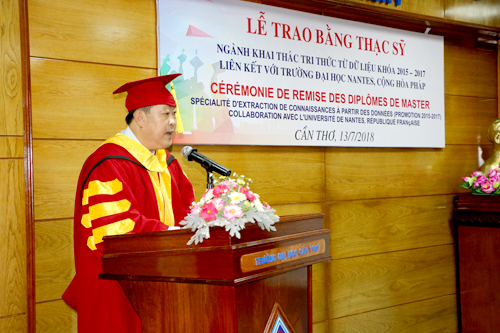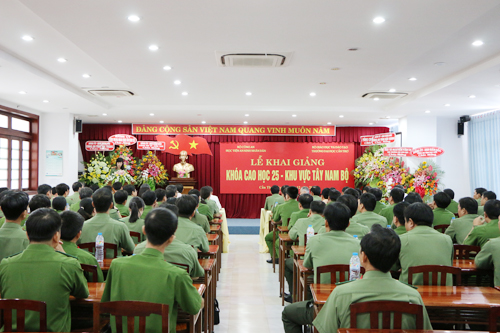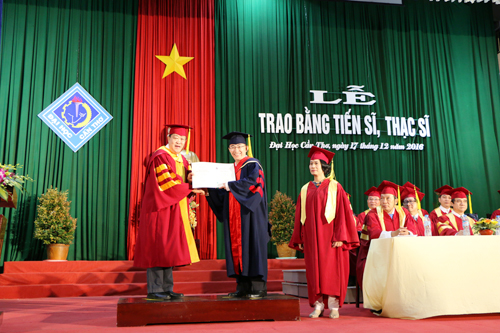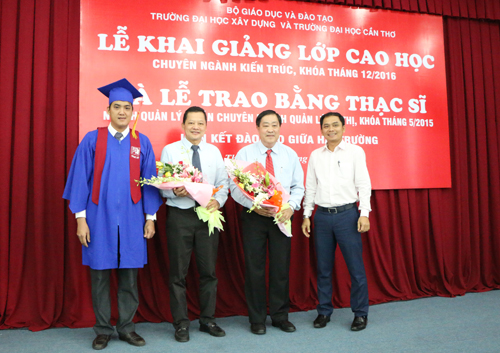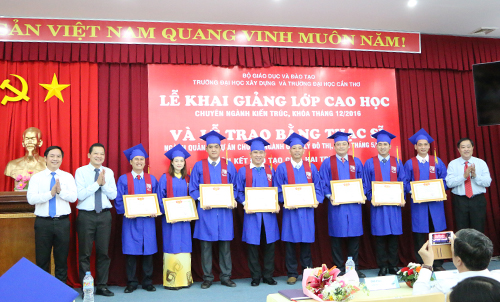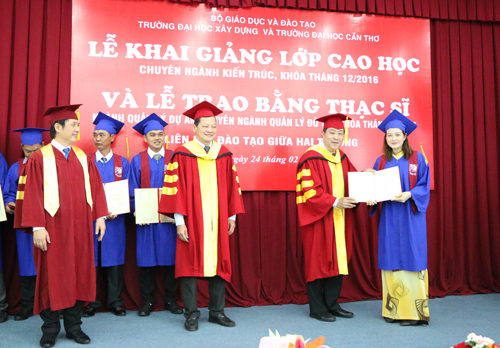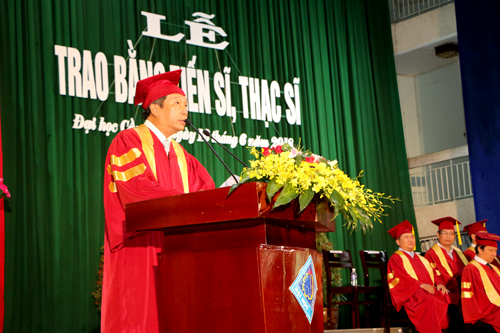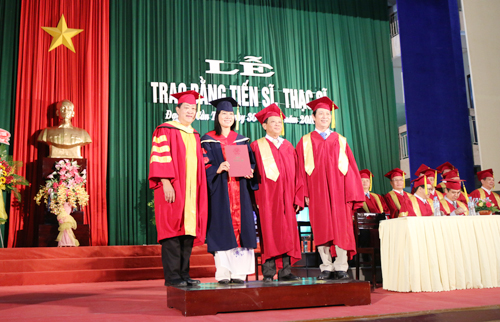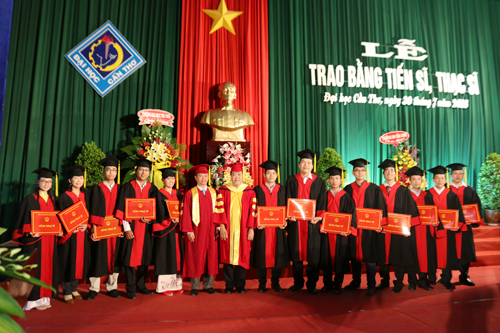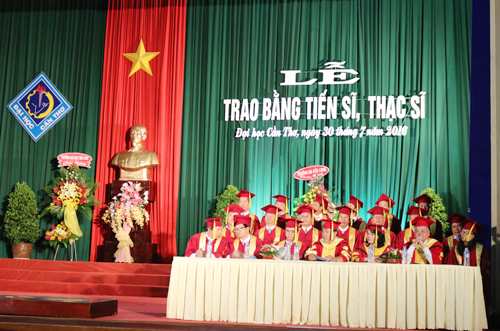
Tên đề tài: “Nghiên cứu giải pháp xử lý nước thải sơ chế gà rán công nghiệp bằng phương pháp ozone kết hợp thủy sinh thực vật”.
Tác giả: Nguyễn Điền Châu, Khóa: 2014
Chuyên ngành: Môi trường đất và nước ; Mã số: 62440303. Nhóm ngành: Khoa học tự nhiên.
Người hướng dẫn chính: PGS.TS. Trương Hoàng Đan - Trường Đại học Cần Thơ.
- 1. Tóm tắt nội dung luận án
Nước thải từ ngành sản xuất thực phẩm ăn nhanh, đặc biệt là nước thải phát sinh từ quá trình tẩm ướp gà rán là loại nước thải có thành phần các hợp chất gia vị, là các hợp chất đa phân tử có tính chất kháng khuẩn, kháng vi sinh vật và kháng nấm. Do tính chất kháng sinh học như vậy nên việc áp dụng trực tiếp các phương pháp sinh học để xử lý loại nước thải này rất khó khăn. Luận án này nghiên cứu giải pháp tiền xử lý xử lý nước thải sơ chế gà rán công nghiệp bằng phương pháp ozone hóa sau đó dùng cây Sậy (Phragmites spp.) trong hệ thống đất ngập nước chảy ngầm ngang để xử lý triệt để chất ô nhiễm.
Tiến hành khảo sát thu mẫu nước thải và phân tích trong 7 ngày liên tục tại nhà máy Jollibee. Kết quả cho thấy nước thải sơ chế gà rán có các thành phần đặc trưng như COD, BOD5, TN (tổng đạm) và TP (tổng lân) với tương ứng nồng độ dao động trong khoảng 1.345-1.425mg/L, 570-600mg/L, 120-140mg/L và 28-40mg/L. Lưu lượng phát thải 70 – 75 m3/ ngày đêm.
Nước thải sơ chế gà rán được tiền xử lý bằng phương pháp ozone hóa, các thí nghiệm 1, 2, 3 và 4 đã được thực hiện nhằm khảo sát giá trị pH, lượng ozone, thời gian phản ứng để xác định thông số tối ưu cho quá trình tiền xử lý. Kết quả cho thấy ở pH = 7, sau khoảng thời gian từ 45-90 phút phản ứng, hiệu suất khử COD đạt trên 40%; Tỷ lệ BOD5/COD tăng từ 0,33 trước phản ứng lên trên 0,53 (tăng 1,61 lần).
Nước thải sau khi tiền xử lý bằng phương pháp ozone hóa được tiếp tục nghiên cứu với các thí nghiệm khác nhau:
- Thí nghiệm 5 nghiên cứu sự hấp thu dinh dưỡng của cây Sậy và xác định nồng độ nước thải thích hợp cho cây sinh trưởng và phát triển. Nước thải được pha loãng bằng nước sạch với nồng độ lần lượt bằng 25%, 50%, 75% và 100% và được cấp vào các nghiệm thức thí nghiệm với các thể tích lần lượt là 06 lít, 09 lít, 12 lít. Kết quả ở nghiệm thức thí nghiệm thế tích nước thải 12 lít và nồng độ nước thải 100%, sau 48 ngày thí nghiệm cho thấy sậy vẫn sinh trưởng và phát triển tốt, khả năng làm giảm chất ô nhiễm TN, TP, BOD5 và COD lần lượt là 70,63%, 76,21%, 77,72% và 61,14% (tăng 11,54%, 12,97%, 18,28% và 21,61% so với ngày đầu).
- Thí nghiệm 6 nghiên cứu ảnh hưởng của mật độ trồng đến khả năng sinh trưởng, phát triển và hấp thu N, P của Sậy. Sậy được trồng với mật độ lần lượt là 20 cây/m2, 25 cây/m2, 30 cây/m2, 35 cây/m2. Kết quả cho thấy sau quá trình thí nghiệm, sậy sinh trưởng tốt và không có sự khác biệt đáng kể giữa các mật độ trồng.
- Thí nghiệm 7 nghiên cứu khả năng xử lý nước thải sơ chế gà rán công nghiệp trong hệ thống đất ngập nước chảy ngầm ngang. Hệ thống được nạp theo dạng mẻ, mỗi nghiệm thức được cung cấp 0,33m3 nước thải với thời gian lưu nước là 03 ngày. Sau 48 ngày thí nghiệm, kết quả cho thấy sậy sinh trưởng và phát triển tốt, chiều cao sậy đạt 170cm, trọng lượng tươi của sậy đạt khoảng 83g/cây (tăng từ 7,1 – 7,4 lần so với ban đầu), tổng sinh khối của cả hệ là 6,76 - 7,12 kg/m2. Hiệu quả xử lý tổng đạm (TN), tổng lân (TP), BOD5 và COD của hệ thống lần lượt là 77,85%, 70,46%, 92,25% và 89,87%. Sậy hấp thu 11,22% TN và 8,88% TP trong nước thải. Tỷ lệ nhu mô xốp (diện tích khoang chứa khí/diện tích lát cắt ngang) ở thân sậy tăng từ 9,91% lên 32,64% và ở rễ tăng từ 17,89% lên 70,81%.
Đề xuất công nghệ xử lý nước thải sơ chế gà rán cho nhà máy Jollibee Việt Nam với công suất 50 đến 100 m³/ ngày. Trong đó có tính toán phương án sử dụng đất, phương án tận dụng sinh khối sậy sau khu thu hoạch và tính toán hiệu quả kinh tế.
Nghiên cứu đã chứng minh sậy thích nghi và phát triển tốt trong môi trường ô nhiễm của nước thải sơ chế gà rán công nghiệp đã tiền xử lý bằng phương pháp ozone hóa. Sinh khối tươi của sậy thu được sau 48 ngày thí nghiệm đạt khoảng 7kg/m2 (tăng khoảng 25 lần so với ban đầu), nước thải sau xử lý đạt tiêu tiêu chuẩn QCVN 40:2011 cột B.
- 2. Những kết quả mới của luận án:
Lần đầu tiên nghiên cứu sự kết hợp sử dụng phương pháp ozone hóa và Sậy trong hệ thống đất ngập nước kiến tạo để xử lý nước thải sơ chế gà rán công nghiệp.
Luận án đã xác định được pH và nồng độ Ozone phù hợp cho quá trình tiền xử lý bằng phương pháp ozone hóa đối với nước thải sơ chế gà rán công nghiệp; Đánh giá được hiệu quả hấp thu N, P và sự phát triển của nhu mô xốp trong cây Sậy; Xây dựng được mô hình hồi quy tổng quát xử lý nước thải sơ chế gà rán công nghiệp của quá trình tiền xử lý bằng phương pháp ozone hóa và quá trình xử lý sậy.
Đề xuất được giải pháp xử lý nước thải sơ chế gà rán công nghiệp bằng phương pháp sử dụng Ozone (có tác nhân điện cực) kết hợp với Sậy trồng trong hệ thống đất ngập nước kiến tạo chảy ngầm ngang.
- 3. Các ứng dụng/khả năng ứng dụng trong thực tiễn, các vấn đề tiếp tục nghiên cứu:
3.1 Ý nghĩa khoa học
Ý nghĩa khoa học quan trọng đầu tiên của luận án là xác định được mối tương quan và dự báo theo chuỗi thời gian thông qua các thí nghiệm ở các tỷ lệ nước thải khác nhau khi sử dụng ozone, điện cực và ozone kết hợp điện cực than để xác định các thông số tối ưu cho quá trình tiền xử lý nước thải. Các mối tương quan được thể hiện qua các phương trình hồi quy trong quá trình thí nghiệm.
Ý nghĩa khoa học thứ hai của luận án là từ kết quả nghiên cứu tác giả đã nghiên cứu quá trình động học của xử lý nước thải sau tiền xử lý bằng cây Sậy. Xác định được hiệu suất xử lý nước thải, đánh giá được sự phát triển của thân cây; bộ rễ; mật độ cây trồng thích hợp. Kết quả nghiên cứu được phân tích, luận giải theo xu thế tuyến tính với các phương trình hồi thế.
Ý nghĩa khoa học thứ ba: Luận án là nguồn tài liệu khoa học cho các nghiên cứu chuyên sâu có liên quan đến lĩnh vực này; Là nguồn tham khảo để đưa vào giảng dạy tại các ngành Kỹ thuật môi trường, Công nghệ môi trường, Quản lý môi trường, Kỹ thuật tài nguyên nước.....ở các trường đại học, cao đẳng; Là cơ sở khoa học để ứng dụng trong xử lý nước thải tại các cơ sở sơ chế gà rán công nghiệp tương tự.
3.2 Ý nghĩa thực tiễn
Kết quả nghiên cứu của luận án góp phần nâng cao nhận thức của xã hội trong việc bảo vệ môi trường và xử lý ô nhiễm môi trường theo hướng sinh thái.
Luận án đã đề xuất công nghệ xử lý nước thải áp dụng cho nhà máy Jollibee; tính toán sơ bộ chi phí vận hành và giá thành xử lý cho nhà máy; Đóng góp này mang ý nghĩa thực tế với nhà máy Jollibee.
Kết quả nghiên cứu của luận án đem lại hiệu quả trong xử lý loại hình nước thải sơ chế gà rán.
3.3 Các vấn đề cần tiếp tục nghiên cứu
Nghiên cứu sử dụng những phương pháp oxy hóa nâng cao khác hoặc kết hợp nhiều phương pháp để có thể rút ngắn thời gian phản ứng của giai đoạn tiền xử lý nước thải.
Nghiên cứu kết hợp hệ thống đất ngập nước chảy dọc (VF – Vertical flow) với hệ thống đất ngập nước chảy ngầm ngang (HF – Horizontal flow) để giảm diện tích đất sử dụng cho quá trình xử lý nước thải.
Nghiên cứu kết hợp phương pháp sử dụng ozone có tác nhân điện cực với sậy trồng trong hệ thống đất ngập nước để xử lý nước thải của loại hình sơ chế gà rán hoặc các loại nước thải có thành phần và tính chất tương tự nước thải sơ chế gàn rán Jollibee.
Nghiên cứu khả năng tận dụng sinh khối sậy để thu hồi năng lượng.
- Summary
Wastewater from the fast food manufacturing industry, especially wastewater generated from the marinating process of fried chicken is the type of wastewater that contains spices. It was polymeric compounds antibacterial, antimicrobial and resistant properties fungi. Due to its antibiotic properties, it is hardly apply biological methods to this wastewater treatment. This thesis researches the solution of pre-treatment of wastewater to pre-treatment industrial fried chicken by Ozonation, then using Phragmites australis. In the horizontal flow constructed wetland system to thoroughly treat pollutants.
After analyzing wastewater samples at Jollibee Factory during 07 days, the results showed that wastewater of fried chicken preliminary has the featured properties such as COD, BOD5, TN & TP with corresponding concentrations in the range: 1.345-1.425mg/L, 570-600mg/L, 120-140mg/L và 28-40mg/L, respectively. The discharge flow is 70 – 75 m3/day.
Fried chicken preliminary was pre-treated by Ozonation. Experiments 1, 2, 3, 4 were carried out to investigate the pH value, Ozone dose, reaction time to determine the optimal parameters for pre-treatment process. The results showed that at pH7, after 45 – 90 minutes reaction time, COD performance reach over 40%, rate of BOD5/COD increased from 0,33 – 0,53 (1,61 times).
Preprocessing fired chicken wastewater from Jollibee has a concentrations of COD, BOD5, TN and TP respectively from 1,345-1,425mg/L, 500-600mg/L, 120-150mg/L and 28-40mg/L. The discharge flow is 70 - 75 m3/day.
Preprocessing fired chicken was pre - treated by Ozonation combined electrodes, experiments 1, 2, 3 and 4 were performed. The results showed that after a period of 45-90 minutes of reaction, COD reduction efficiency was over 40%; The ratio of BOD5/CODtb increased from 0,33 before the reaction to over 0,53 (an increase of 1,61 times).
Wastewater after pre-treatment by ozonation is continued to research with different experiments:
- Experiment 5 studies the nutrient uptake of Phragmites australis plants and determines the concentration of wastewater suitable for plants to grow up and develop. Wastewater was diluted by clean water with concentrations equal to 25%, 50%, 75% and 100% respectively and was fed into the experiments with the volumes of 06 Liter, 09 Liter, and 12 Liter respectively. The results showed that 12L wastewater volume and 100% wastewater concentration, after 48 days of experiment, showed that phragmites australis still grow up and develop good, the ability to reduce pollutants TN, TP, BOD5 and COD 70,63%, 76,21%, 77,72% and 61,14% respectively (up 11,54%, 12,97%, 18,28% and 21,61% compared to the first day).
- Experiment 6 studies the effects of planting density on the growth, development and absorption of N, P of Phragmites australis. Phragmites australis were planted with the density of 20 plants/m2, 25 plants/m2, 30 plants/m2, 35 plants/m2. Results showed that after the experimental period, the Phragmites australis grew well and there was no significant difference between the planting densities.
- Experiment 7 studies the possibility of treating industrial preprocessing fired chicken treatment wastewater in the horizontal flow constructed wetland system. The system was loaded in batches, each treatment was provided with 0,33m3 of wastewater with a Hydraulic retention time of 03 days. After 48 days of experiment, the results showed that the common Phragmites australis grew up and developed well, the Phragmites australis’s height reached 170 cm, the fresh biomass of this Phragmites australis was about 83g/plant (increased from 7,1 to 7,4 times compared to the initial), the total biomass of the whole system is 6,76 – 7,12 kg/m2. The treatment efficiency of the system's total nitrogen (TN), total phosphorus (TP), BOD5 and COD are 77,85%, 70,46%, 92,25% and 89,87%, respectively. Phragmites australis absorb 11,22% TN and 8,88% TP in wastewater. The ratio of aerenchyma in shoot of Phragmites australis has increased from 9,91% to 32,64% and in the roots increased from 17,89% to 70,81%.
Offering wastewater treatment technology for Jollibee Long An Factory for fried chicken preliminary process with a capacity 50 – 100 m3/day. Including land – use planning, plans to utilize the post harvest common reed biomass and economic efficiency.
The study has demonstrated that Phragmites australis adapt and thrive in the polluted environment of industrial fried chicken pre-treated wastewater by ozonation and electrodes. The fresh biomass of common reed obtained after 48 days of experiment was about 7 kg/m2 (increased of about 25 times), the treated wastewater reached QCVN 40: 2011 column B.
- The novel aspects from the thesis
1/ The first time research on the combination of using ozonation and common reed in wetland system to treat industrial fried chicken preliminary treatment wastewater.
2/Determined the appropriate pH and ozone dose for the pre-treatment by ozonation for industrial fried chicken preliminary treatment. The thesis had evaluated the N, P uptake efficiency and the development of the aerenchyma in common reeds. Developed a general regression model for industrial fried chicken pre-treatment by ozonation and common reed.
3/ Proposed a solution to preliminary treatment of industrial fried chicken wastewater by ozonation (with coal electrodes) combined with common reed in a horizontal subsurface flow.
- Applications/Scientific and practical values of the study, In the future, study problems
3.1. Scientific values
1/ The first important scientific significance of the thesis: determined the correlation and prediction over time series through experiments at different wastewater rates using ozone, electrodes and electrodes combined ozone to determine the optimal parameters for wastewater pre-treatment. Correlations are showed through regression equations during the experiment.
2/ The second scientific significance: the thesis had studied the kinetics of wastewater treatment after pre-treatment with common reed, determined the wastewater treatment efficiency, development of stem; the roots and the density plants. The results were analyzed and interpreted according to the linear trend with regression equations.
3/ The third scientific significance: The thesis willing to be the scientific resource for post hoc studies related to this field; a reference source to teach in the fields of Environmental Engineering, Environmental Technology, Environmental Management, Water Resources Engineering ... in universities, colleges; the scientific basic for application in wastewater treatment in industrial fried chicken preliminary treatment facilities.
3.2. Practical values
1/ Contributing to raising the society's awareness in environmental protection and ecological treatment of environmental pollution.
2/ Proposing solutions for wastewater treatment for Jollibee factory; calculation of operating costs and treatment costs; This contribution has practical significance for the Jollibee factory.
3/ Bringing about efficiency in wastewater treatment, preliminary processing of fried chicken
3.3. Recommended further study
1/ Research other advanced oxidation methods or combine many methods to minimise the reaction time of the wastewater pre-treatment period.
2/ The study on combining the Vertical flow systems with the horizontal flow wetlands to reduce the area of land used for wastewater treatment.
3/ The study combines the use of electrodes ozone with reeds grown in wetland systems to treat the wastewater of fried chicken preliminary treatment or wastewater with similar composition and properties. Preliminary fried Jollibee.
4/ Research on the possibility of utilizing reed biomass for energy recovery.
- Xem chi tiết nội dung luận án
- Xem thông tin đăng tải tại Website Bộ giáo dục và Đào tạo. (Nhập tên NCS vào ô tìm kiếm)





